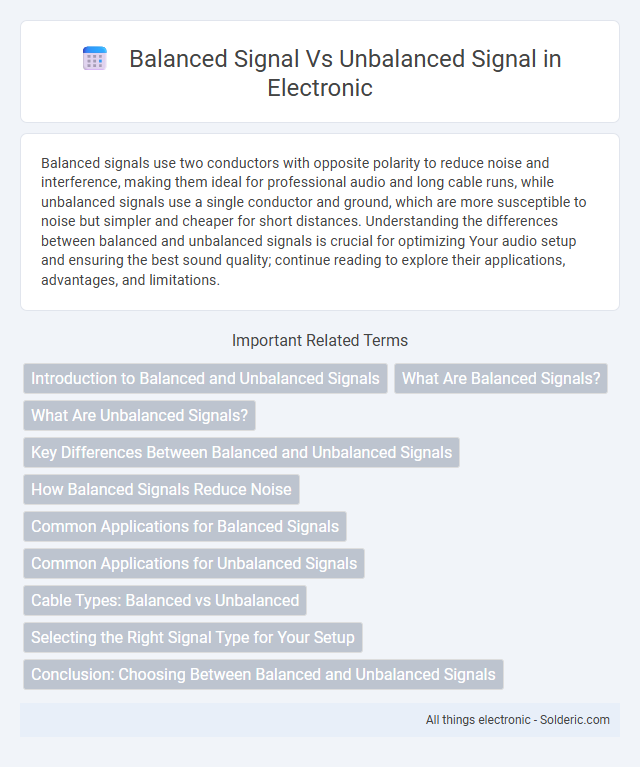Balanced signals use two conductors with opposite polarity to reduce noise and interference, making them ideal for professional audio and long cable runs, while unbalanced signals use a single conductor and ground, which are more susceptible to noise but simpler and cheaper for short distances. Understanding the differences between balanced and unbalanced signals is crucial for optimizing Your audio setup and ensuring the best sound quality; continue reading to explore their applications, advantages, and limitations.
Comparison Table
| Feature | Balanced Signal | Unbalanced Signal |
|---|---|---|
| Definition | Two signal conductors with equal impedance | Single signal conductor with ground reference |
| Noise Rejection | High (common-mode noise cancellation) | Low (prone to electromagnetic interference) |
| Typical Connectors | XLR, TRS (Tip-Ring-Sleeve) | TS (Tip-Sleeve), RCA |
| Cable Type | Twisted pair with shield | Single conductor with shield |
| Signal Quality | Maintains integrity over long distances | Signal degradation over long cable runs |
| Typical Use | Professional audio, studio, live sound | Consumer audio, short patch cables |
| Cost | Generally higher due to complexity | Lower, simpler design |
Introduction to Balanced and Unbalanced Signals
Balanced signals use two conductors carrying equal and opposite signals, minimizing noise interference in audio and data transmission. Unbalanced signals rely on a single conductor with a ground reference, making them more susceptible to electromagnetic interference over long distances. Your choice between balanced and unbalanced signals impacts the overall signal clarity and noise performance in professional audio or communication systems.
What Are Balanced Signals?
Balanced signals use two conductors carrying equal and opposite voltage levels, which significantly reduces noise and interference in audio and data transmission. This method enhances signal integrity over long cable runs by allowing external noise to be canceled out through differential signaling. Commonly found in professional audio equipment, balanced signals improve clarity and reduce hum compared to unbalanced signals.
What Are Unbalanced Signals?
Unbalanced signals use two conductors: a signal wire and a ground wire, making them more susceptible to noise and interference over long distances. Commonly found in consumer audio equipment, unbalanced signals rely on the ground as a reference point, which can introduce hum and signal degradation. For your audio setup, understanding that unbalanced connections are best suited for short cable runs can help maintain sound quality.
Key Differences Between Balanced and Unbalanced Signals
Balanced signals use two conductors with equal impedance to ground and a separate ground wire, reducing noise and interference in audio transmission. Unbalanced signals rely on a single conductor and ground, making them more susceptible to electromagnetic interference over long distances. Your audio setup benefits from balanced signals when using professional equipment, while unbalanced signals are common in consumer devices for shorter cable runs.
How Balanced Signals Reduce Noise
Balanced signals reduce noise by using two conductors that carry identical audio or data signals with opposite polarities, allowing interference picked up along the cable to be canceled out at the receiving end. This method significantly lowers electromagnetic interference and radio frequency noise, especially in long cable runs commonly found in professional audio and communication systems. Your equipment benefits from clearer, more reliable signal transmission, ensuring higher sound quality and reduced noise distortion.
Common Applications for Balanced Signals
Balanced signals are commonly used in professional audio environments, including studio recording, live sound reinforcement, and broadcast systems, where noise rejection and signal integrity over long cable runs are critical. They are preferred for connecting microphones, mixers, and audio interfaces due to their ability to reduce electromagnetic interference and hum. Balanced connections often utilize XLR or TRS cables, ensuring high-quality audio transmission in demanding settings.
Common Applications for Unbalanced Signals
Unbalanced signals are commonly used in consumer audio equipment such as guitars, keyboards, and home stereo systems, where short cable runs reduce susceptibility to interference. These signals typically utilize two-conductor cables, like RCA or TS connectors, making them cost-effective for everyday applications. Your choice of unbalanced connections is ideal for environments with minimal electrical noise and straightforward audio setups.
Cable Types: Balanced vs Unbalanced
Balanced cables use three conductors: two signal wires carrying equal and opposite signals and a ground wire, effectively reducing noise and interference over long distances. Unbalanced cables contain two conductors, a single signal wire and a ground, making them more susceptible to electromagnetic interference, especially in longer runs. Common balanced cables include XLR and TRS connectors, while unbalanced cables typically use TS connectors or RCA plugs.
Selecting the Right Signal Type for Your Setup
Selecting the right signal type for your setup depends on factors such as cable length, interference, and equipment compatibility. Balanced signals use three conductors to reduce noise and are ideal for long cable runs and professional audio environments, while unbalanced signals utilize two conductors, suitable for short distances and consumer-grade gear. Understanding these differences ensures Your audio system performs optimally with minimal noise and signal degradation.
Conclusion: Choosing Between Balanced and Unbalanced Signals
Selecting between balanced and unbalanced signals depends on the application's noise environment and distance requirements. Balanced signals use differential transmission to minimize electromagnetic interference, making them ideal for long cable runs and professional audio settings. Unbalanced signals, simpler and cost-effective, are suitable for short distances and less noisy environments where signal degradation is minimal.
Balanced signal vs unbalanced signal Infographic

 solderic.com
solderic.com